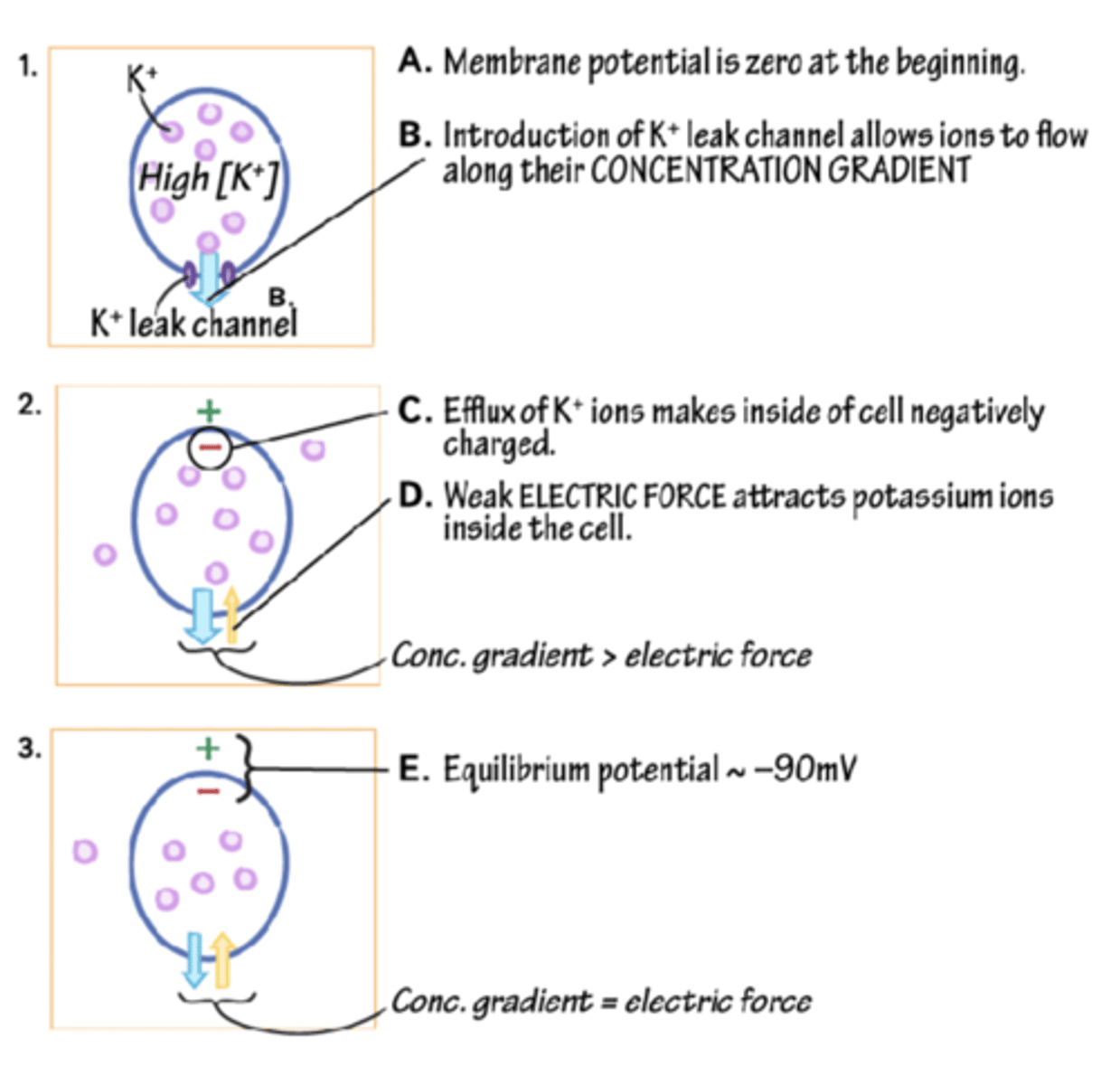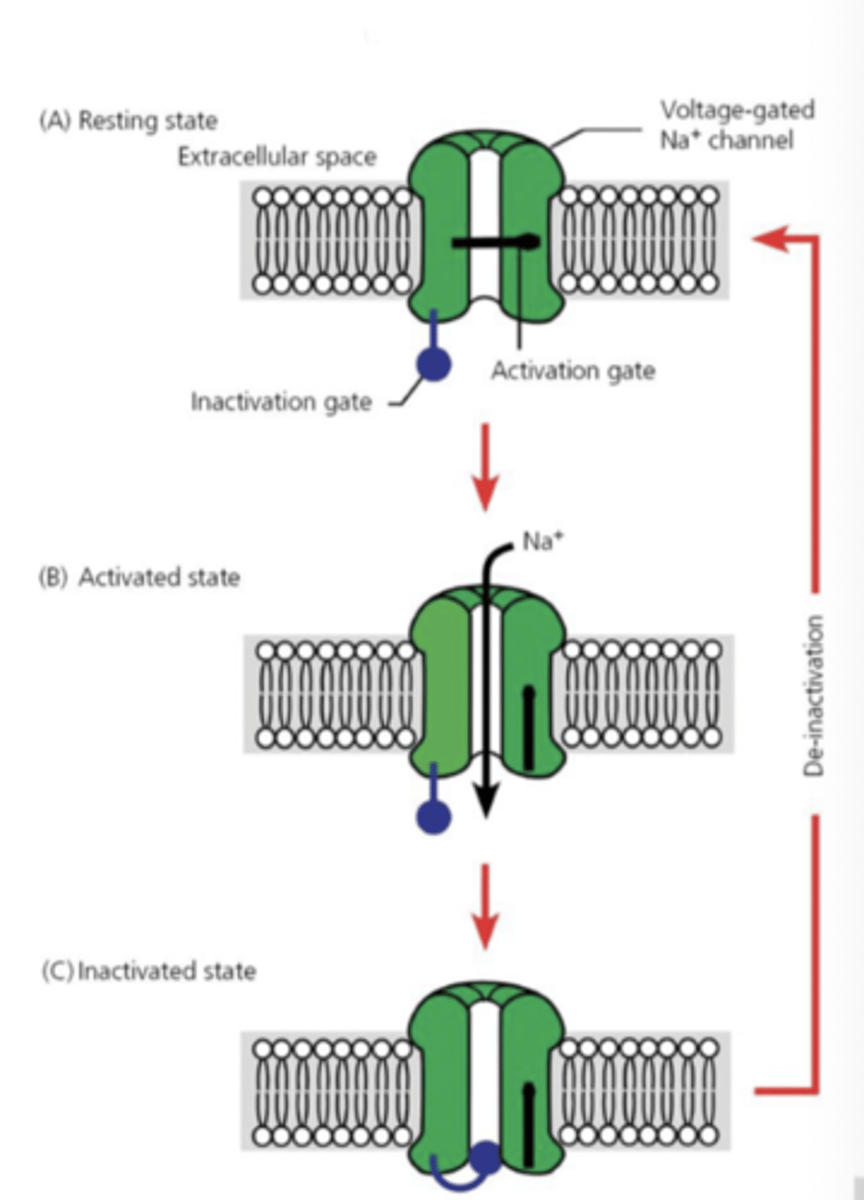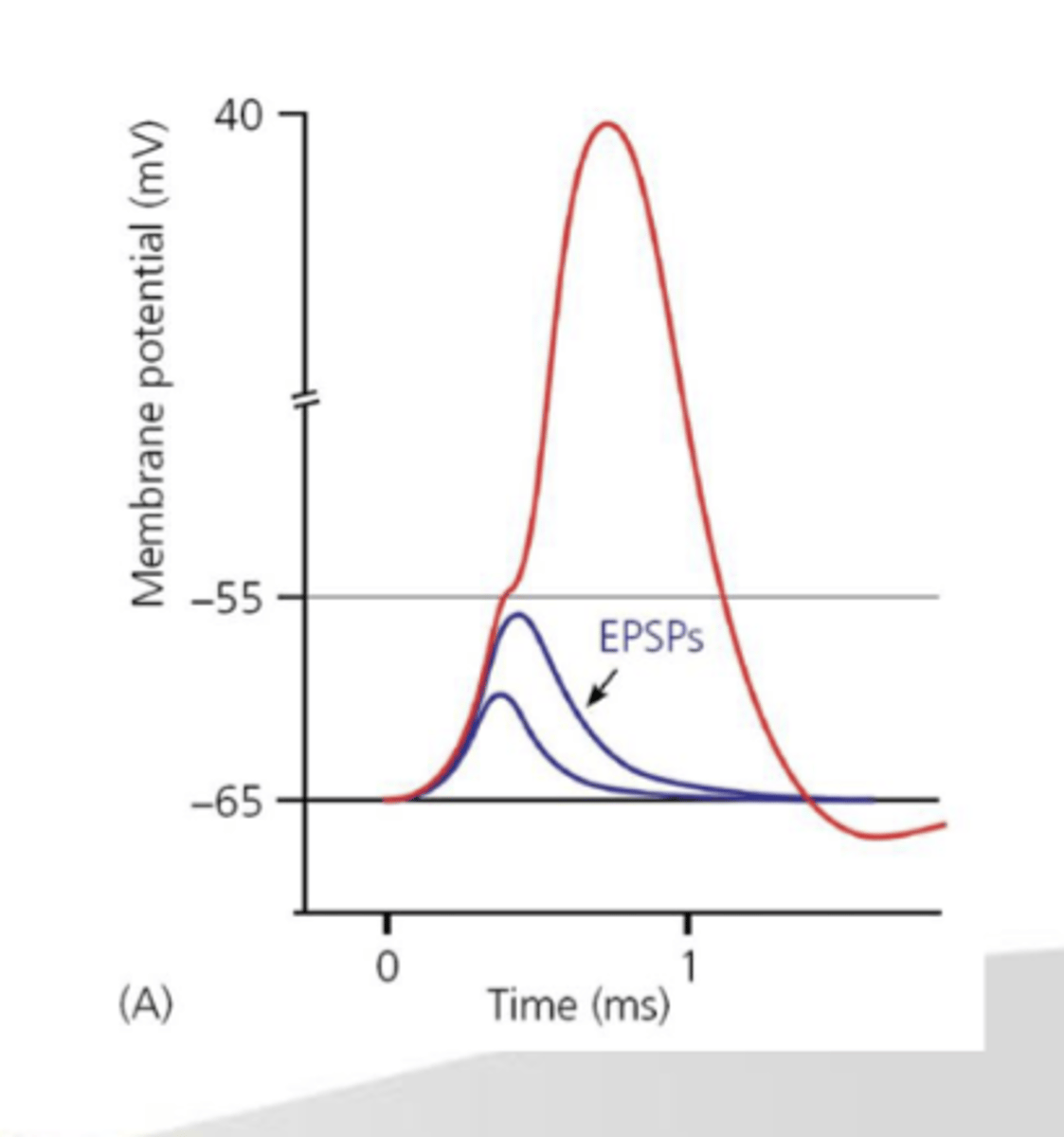Lecture 3 - Equilibrium, Resting Membrane, and Action Potentials
1/52
There's no tags or description
Looks like no tags are added yet.
Name | Mastery | Learn | Test | Matching | Spaced |
|---|
No study sessions yet.
53 Terms
RMP stands for what?
resting membrane potential
What is a resting membrane potential?
potential difference that exists across membranes in the period between action potentials
RMP is established by diffusion potentials and is defined as what?
the potential difference generated across a membrane when a charged ion diffuses down concentration gradient
- can be positive or negative, depending on charge of ion
RMP is set by by what channels?
RMP is maintained by what pump?
K+ leak channels
Na+/K+ ATPase pump
Ions with _______ permeabilities contribute most to RMP (K+, Cl-)
high
K+ separated from immobile anions inside cell
RMP range?
usually -70 to -90 mV
What does the Na+/K+ ATPase pump do for the RMP?
helps to maintain K+ concentration gradient across the membrane
- helps to set K+ diffusion potential
- potassium is high inside the cell & wants to diffuse out of the cell (sodium coming, potassium coming out)
Since potassium is leaking out of the cell & carries a positive charge, is the inside of the cell negative or positive?
negative
Which ion will be attracted to the inside of the cell because it's negative in the cell?
Na+
Resting membrane potential is always close to ______________ equilibrium potential
potassium (K+)
Why is RMP negative?
There are more NEGATIVE charges on the INSIDE
- more Na+ ions outside cell than K ions inside cell (membrane more permeable to K+ than Na+)
K equilibrium potential is what?
-85 to -90 mV
When is K+ in equilibrium?
when cell is 85-90 mV lower than EC environment
Define K+ equilibrium potential
movement of K+ INTO cell because of negative electrical potential is balanced by diffusion of K+ OUT of cell due to concentration gradient

True or false?
At K+ equilibrium, electrical and diffusion forces are equal and opposite: movement stops!
True
What are the typical values for equilibrium potentials (Na+, Ca2+, K+)?
Na+ = +65 mV
Ca2+ = +120 mV
K+ = -85 mV
Define driving force
difference between the measured membrane potential and the ion's calculated equilibrium potential
When driving force is negative, ion will do what?
enter the cell if it is a cation and leave cell if it is an anion
- membrane potential is too negative = try to bring it towards equilibrium potential
Define action potential
quick electrical pulse that travels along a nerve cell, allowing it to send signals
- transmit information in nervous system and all muscle
Action potentials occur in what kind of cells?
excitable cells = rapid depolarization followed by repolarization
- cells need to be excitable for this to happen
Define depolarization
membrane potential becomes less negative
Define hyperpolarization
membrane potential becomes more negative
- hard to get another AP in that time
Define inward current
flow of positive charge into cell
- sodium
Define outward current
flow of positive charge out of cell
- potassium
Define threshold potential
membrane potential at which an AP is inevitable
Define overshoot
portion of AP where membrane potential is positive
Define undershoot
portion of AP where membrane potential is more negative than RMP
- time where there is hyperpolarization happens
Define refractory period
period during which another AP can't be generated
Depolarization: ____________ enters the cell
sodium (Na+)
Depolarization: ______________ leaves the cell
potassium (K+)
Define depolarization = Sodium (Na+) influx
during an action potential, when the cell becomes less negative and more positive inside, this is called depolarization, it happens because sodium ions rush into the cell
Define repolarization = Potassium (K+) efflux
after the cell reaches its peak positive charge, it needs to return to its resting state, this is called repolarization, and it happens because potassium (K+) ions flow out of the cell, making the inside more negative
What are the events of AP
1. RMP is -70 mV, K+ conductance is high, Na+ conductance is low
2. upstroke of AP - membrane depolarized to threshold (-60 mV): voltage gated Na+ channel
3. repolarization - inactivation gates on Na+ channels close and K+ channels open
4. undershoot (hyperpolarization) - K+ conductance higher than at rest
Explain events of AP
Resting Membrane Potential (-70 mV): The cell is quiet. Potassium (K++) moves easily, but sodium (Na++) does not.
Upstroke of Action Potential: The cell gets a signal and depolarizes (becomes less negative) to -60 mV. Sodium (Na++) channels open, and Na++ rushes in.
Repolarization: The cell starts to reset. Sodium (Na++) channels close, and potassium (K++) channels open, allowing K++ to leave the cell.
Undershoot (Hyperpolarization): The cell goes a bit too negative because potassium (K++) channels stay open longer, making K++ leave even more than usual.
Define refractory periods
excitable cells unable to produce normal APs
Define absolute refractory period (ARP)
- overlaps with most of the AP
- no stimulus can occur to cause another AP
- inactivation gates on Na channels remain closed, once they are closed they reamin closed until cell repolarized
Define relative refractory period (RRP)
- from end of ARP until through most of hyperpolarization
- AP occurs with greater than normal depolarization
- could have another AP but it takes more stimulus to reach threshold
Explain the refractory periods:
A - resting state
B - activated state
C - inactivated state
A = at resting membrane potential
- activation gate closed
- not going to let any sodium in
- potassium is leaking out
B = activated by signal
- voltage gated
- ligand gated
- activation gate opens
- sodium comes in making cell more positive
C = inactivated state
- time and return to RMP required to reset
- refractory to subsequent stimulus
- inactivation closed

What are the characteristics of AP
Size and shape typical for a given cell
- cardiac cell vs pacemaker cell
Propagation
- AP propagate and move because depolarization spreads to adjacent areas on the membrane
- need many AP
All-or-non response
- depolarization either causes action potential or doesn't, either brings cell to threshold or doesn't, once you reach action potential you get AP

What are the propagation of APs
APs start close to the cell body of a neuron, spread down the axon via local currents
1. initial area of axon depolarized to threshold, AP fires, cell interior positive
2. positive charges inside cell flow towards negative charges in adjacent areas of cell - those ares then depolarized to threshold
3. at this point, the initial area has repolarized
What are the conduction velocity of APs
speed at which an AP travels along a nerve or muscle fiber
Define time constant
how quickly a membrane depolarizes in response to inward Na+ current
What affects the time constant?
membrane resistance and capacitance
Define resistance
if we have a high membrane resistance the current doesn't readily flow across the membrane
- it will force the current to spread internally which is not a bad thing = it is a path of least resistance
- putting a myelin sheath on a nerve cell
When you have high membrane resistance, you [increase/decrease] the time constant?
increase
Define capacitance
ability of membrane to store charge
high capacitance, [increases/decreases] the time constant
increases
- current coming in (Na current) = must discharge membrane before depolarization can occur
Define length constant
how far depolarization current will spread along a nerve
what affects length constant?
membrane resistance and internal resistance
- longer length constant means the current wills pread farther
- internal resistance in a cell is inversely related ot how ieasily that current spreads within cytoplasm
look this one up
Explain increase conduction velocity
1. increase size of the nerve fiber
- by increasing diameter of fiber, the internal resistance decreases
- anatomical limits to nerve size
2. myelinate the nerve fiber
- insulation of nerves with lipid will increase membrane resistance and decrease capacitance
- myelinate with lipids
Where are there breaks in myelin sheath?
every 1-2 mm = nodes of Ranvier
@ nodes = membrane resistance LOW
@ myelin sheaths = membrane resistance HIGH
- action potentials happen at every break in the sheath
What does the myelination allow to happen?
the current to move fast and deplarize every point of membrane and allowing it to move quickly in the breaks
Define saltatory conduction
APs jump from node to node